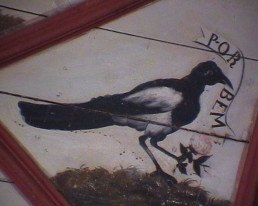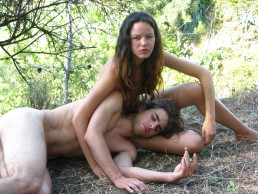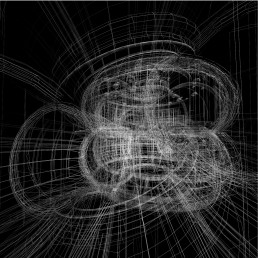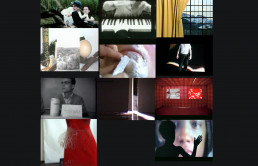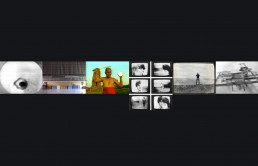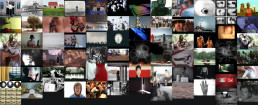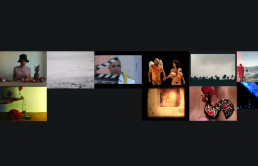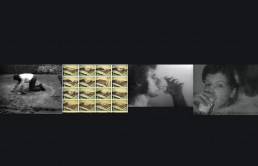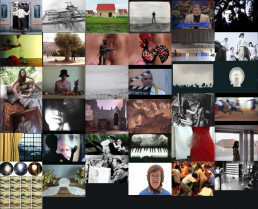FUSO 2010 – Programa 31 Julho, 23h30
Museu Coleção Berardo
OPEN CALL
2ª Sessão de projeção competitiva do Open Call do FUSO 2010 aos artistas portugueses, com seleção de Elsa Aleluia
Duração total da projeção 69’03’’
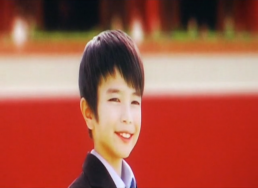
José Maçãs de Carvalho, Des Voeux Road (forever young), Portugal, 3’48’’
Um jovem chinês permanece jovem para sempre, numa rua de Hong Kong.
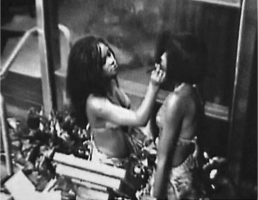
Paula Albuquerque, GMT minus 5, Portugal, 5’01’’
Duas jovens trabalham num bar em Nova Iorque. No meio do Inverno, estão praticamente em biquíni, condição obrigatória ou “farda”, de acordo com o tema tropical do bar. Passam o dia à espera que algo aconteça. Matam o tempo retocando a maquilhagem, falando ao telefone, recebendo clientes esporádicos.
Através de um trabalho de montagem de imagem e de som procuro construir e desconstruir possíveis narrativas, imprimir ambientes constantemente destabilizados pela inclusão de ruídos, música atonal, sons de rua, manipulações e sugestões de soundscapes. Quebrando a harmonia, procurando nos espaços intermédios a experiência do momento, mesmo que este exista unicamente num espaço-tempo virtual.
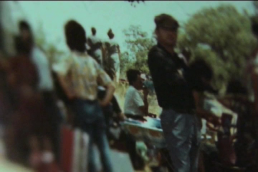
Susana Moura, Rodoviária Nacional, Portugal, 1’44’’
Rodoviária Nacional é um de uma série de curtos vídeos. Cada vídeo é feito a partir de uma única fotografia. Através da apropriação da linguagem cinematográfica – edição e sonorização – é criado um jogo de tensões, sugerindo narrativas mais ou menos abstratas.
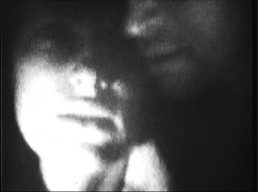
Cláudia Clemente, Amor, Portugal, 5’44’’
Amor é uma reflexão sobre as contradições e mal-entendidos que existem em toda a relação amorosa. As palavras sobrepostas, as frases contraditórias, as repetições até à exaustão, a ausência de sentido, a fronteira tão ténue com ódio, o testar de limites para a nossa capacidade de aguentar aquilo que já não conseguimos entender, a descontextualização total ou parcial do discurso amoroso, cujas palavras adquirem novos sentidos – tudo isso é objeto deste vídeo.
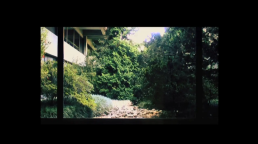
André Uerba, Aquarium, Portugal, 1’03’’
Existem muitos componentes diferentes num jardim. A luz, a cor, o céu, o movimento. Em Aquarium observamos uma imagem quase estática. Não nos apercebemos do movimento até que um pássaro aparece.
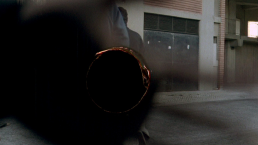
Pedro Maia, Arize (Zona), Portugal, 10’
Partindo da recente longa metragem A Zona, realizada por Sandro Aguilar, Arise (Zona) pretende concretizar todo o lixo cinematográfico posto de parte aquando da conceção e montagem de um filme, utilizando os metros de película gastos que são entendidos como lixo e que na maior parte das vezes nem sequer são digitalizados. Arise (Zona) é toda a sujidade, todos os erros que são tendencialmente evitados, esquecidos ou simplesmente ignorados. É essa sujidade, esse “lixo”, que pretendo fazer emergir; tudo o que é normalmente omitido e invisível e aquilo a que não temos acesso. A emersão das imagens impressas nos desperdícios de película, votadas ao vazio e ao esquecimento absoluto darão, subversivamente, lugar a uma nova leitura e a um novo sentido.
Referindo-se a um espaço emocional limite, a uma dimensão psicologicamente densa e alterada, Arise (Zona) reporta um lugar de ambiguidade e indeterminação entre vida e morte no qual a narrativa e lógica temporal são suspensas. Eis a película lado a lado com a sua própria sepultura, num processo autofágico em direção à morte. Vivendo nos momentos finais do cinema químico é urgente concretizar a materialização do mesmo.
Prémio do Público
Rui Mourão, Por Bem, Portugal, 6’43’’
Este vídeo surge numa linha de pesquisa que Rui Mourão tem vindo a desenvolver, onde usa a sua própria experiência pessoal ao nível de vivências laborais em trabalhos temporários por onde tem passado (ensino, call centers, arquivos, teatros, museus, etc). Ao apropriar e subverter situações do campo da utilidade, da funcionalidade e da necessidade para criar um trabalho artístico, procura conquistar um espaço de liberdade. Por isso o faz nos próprios locais e horários laborais. Este vídeo foi feito enquanto Rui Mourão trabalhou como assistente no Palácio Nacional de Sintra.
O título deste trabalho – Por Bem – parte de uma divisa de D. João I pintada repetidamente no teto de uma das salas do Palácio Nacional de Sintra e em relação à qual estão associadas lendas e narrativas.
Neste trabalho o artista grava-se transportando um retrato tido durante muito tempo como sendo de D. Sebastião. Este é o mesmo quadro ao qual Rui Mourão já havia tirado o pó no vídeo Do outro lado do quadro (o pó da História). O referido quadro é uma cópia atribuída a Alonso Sanchez Coello, a partir de um original da pintora Sofonisba Anguissola, realizado em Espanha como retrato do Infante D. Carlos (filho de Filipe II de Espanha e de D. Maria de Portugal, que viveu entre 1545 e 1568; e primo de D. Sebastião, com quem era fisicamente parecido). A pintura foi modificada algures no tempo para incluir legenda e atributos identificativos do monarca desaparecido em Alcácer-Quibir, apresentando um posterior repinte com as armas portuguesas e a seguinte inscrição: “Retrato del Rei D. Sebastião I, décimo sexto de Portugal, feito na era de 1671”. Exames radiológicos revelaram que foram acrescentados outros elementos à pintura original. Particularmente digna de atenção é a descoberta de que pendente do colar ao pescoço do rei, estava primitivamente o “Tosão de Ouro” (alta ordem ligada a Espanha concedida ao Infante D. Carlos). Atualmente tem pintado no seu lugar um medalhão com a cruz da Ordem de Cristo (símbolo ligado a Portugal, usado através dos tempos, tanto nas velas das naus dos Descobrimentos como em diversas organizações e instituições políticas e militares, inclusive atuais).
Ao transportar o quadro de D. Sebastião, ao tocá-lo e mudá-lo de um lugar para outro por um percurso de salas do palácio (aquelas a que se associam lendas e mitos: Sala dos Cisnes, Sala das Pegas, Quarto de D. Sebastião, Sala dos Brasões, Quarto de D. Afonso VI), está-se implicitamente a afirmar a sua transitoriedade: porque é um objeto frágil, porque a sua identificação foi abalada, porque a entidade que simboliza – a de uma consciência nacional construída após 1640 e apropriada com finalidades diversas ao longo da história – é tudo menos eterna, a-histórica e mítica. Tomou-se assim o quadro e as ações desempenhadas pelo artista, para refletir sobre questões ligadas à identidade nacional, aos seus mitos e a legitimações históricas com base em construções ficcionais.
Contudo, ver neste projeto apenas a desmistificação da identidade portuguesa consubstanciada numa imagem que se revela falsa é restringir-lhe o significado. Há também, no vídeo, o lugar, o cenário majestoso onde tudo se passa: um palácio que já foi residência de reis e é hoje um museu, ou seja, o lugar onde a história se concentra e se expõe vertiginosamente como objeto de consumo. Rui Mourão considera o museu como uma entidade viva, habitada aqui pelo corpo de quem nele trabalha. Arquivo vivo, o museu é também, paradoxalmente, o relicário onde a história se encerra. D. Sebastião está no museu, o seu retrato pode ser falso, mas o artista regressa a ele uma e outra vez para, agora, definir a sua identidade pessoal.
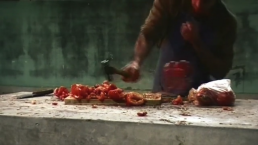
André Pinto, La Petite Mort, Portugal, 4’57’’
O vídeo explora “a pequena morte” (la petite mort, expressão francesa para o orgasmo) e a “morte” nela contida. É-nos inicialmente apresentada, com o acender das luzes, uma natureza morta, um saco de tomates sobre um balcão. O “assassino”/artista surge dentro de um plano que o “corta pelo pescoço” não sendo visível a sua cabeça. Liga a música (ópera), pousa as ferramentas sobre a mesa, veste um avental e dá início à “carnificina” martelando os tomates um por um. Enquanto os tomates são desfeitos ouvem-se gemidos femininos com cada pancada até ao clímax final do último tomate. O martelo é então atirado sobre a mesa, o avental despido e o sujeito desaparece, deixando-nos com a última natureza morta. As luzes apagam-se.
Pedro Henriques, Forest of Confusion, Portugal, 8’
Constituído por quatro momentos, este vídeo invoca deambulações místicas, narrativamente abertas, situações artificiais, mas em parte verosímeis. Um círculo fechado, apertado, mas que em algum momento se deixa ver e revelar. Cabe ao espectador deixar-se também confundir e abrir mundo entre as imagens.

Sérgio Cruz, Exótica, Portugal, 5’
Exótica é o resultado de uma residência de três semanas em Maputo (Moçambique), em Março de 2008, com o coreógrafo português Miguel Pereira.
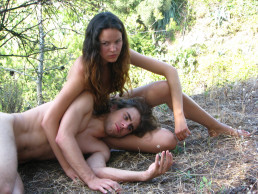
David Bonneville, Éden, Portugal, 1’17’’
Adão e Eva descansam num Éden contemporâneo depois de fazerem amor.

Julieta do Vale, Futuro Próximo, Portugal, 4’40’’
A câmara permanece imóvel, revelando uma imagem em movimento através da sua composição e iluminação. O movimento e som das bolas de golfe, a música e a paisagem noturna são elementos que criam um relacionamento com a ideia de passagem do tempo e a noção do efémero.
Filmado no Suita Golf Club em Osaka, Japão.
O vídeo faz parte do meu projeto de fotografia e vídeo realizado com o Subsídio de apoio a criação artística da Fundação Calouste Gulbenkian.

Nuno Rodrigues de Sousa, Sobreposição a Negro, Portugal, 11’36’’
Sobreposição a Negro regista, em plano fixo, o processo de construção de uma pintura sobre uma superfície transparente (um vidro) que se situa entre a câmara e uma paisagem natural. Os limites deste vidro não são visíveis na imagem: ele situa-se paralelo à câmara e ocupa a totalidade do plano. Inicialmente esta superfície não é percetível mas, quando surge em cena o pintor, torna-se visível através dos seus reflexos. O pintor posiciona-se em segundo plano relativamente à superfície e começa a delimitar, com fita-cola, as áreas que vai pintar. A pintura consiste em duas listas horizontais a negro, em cima e em baixo, na superfície transparente, pintadas no limite do enquadramento, estreitando a vista da paisagem que se situa atrás, numa tentativa de reconfiguração da imagem. A pintura negra funciona aqui como uma alusão às letterbox que resultam da conversão da imagem em ecrã panorâmico, 16:9, para o formato 4:3.
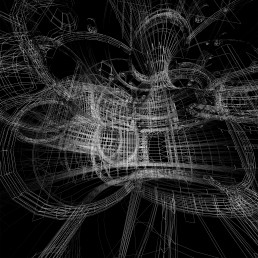
João Ó, Lost Portrait, Portugal, 1’30’’
Lost‐portrait envolve a criação de uma estrutura espacial concebida inteiramente num espaço virtual que consiste na modulação de um objeto finito dentro de um espaço infinito. Trata‐se de uma construção tridimensional gerada a partir de linhas interligadas entre si que, à primeira vista, aparentam sugerir um emaranhado caótico. No entanto, numa aproximação mais cautelosa, esta teia digital desdobra‐se numa sucessão de superfícies tubulares que se contorcem e convergem para pontos de fuga inesperados; formas que contêm e expulsam o fluxo cíclico do vacuum – um habitáculo do pensamento ausente.
O vídeo desenrola‐se no espaço‐tempo compreendido entre as duas imagens fotográficas (#3.25 e #5.14) que correspondem ao início e final de um percurso. Ao som da leitura de um poema, especialmente concebido para esta peça, uma voz hipnotizante do sexo feminino anuncia o encadear da ação. A duração da leitura do poema coincide com a do vídeo que circunscreve, assim, o ato poético.
O “retrato” aqui enunciado não corresponde à designação comum do termo, mas pretende, em última instância, revelar uma fisionomia interna, uma superfície familiar, a potência de um abismo. Por outras palavras, o espaço psicológico criado remete para um lugar suspenso onde a memória – a retroprojeção do sujeito – resiste à erosão dos acontecimentos.
FUSO 2010 – Program July 30th, 11h30pm
Museu Coleção Berardo
OPEN CALL
2nd Competitive screening session of FUSO 2010’s Open Call to Portuguese artists, works selected by Elsa Aleluia
Total running time 69’03’’

José Maçãs de Carvalho, Des Voeux Road (forever young), Portugal, 3’48’’
A young Chinese boy stays forever young in a street of Hong Kong.

Paula Albuquerque, GMT minus 5, Portugal, 5’01’’
Two girls work in a New York bar. In the middle of the winter they are half-naked, mandatory condition or uniform in accordance with the tropical theme of the bar. They kill time retouching make-up, talking on the phone, receiving the odd customers.
Through image and sound editing, possible narratives are built and deconstructed, while ambients and atmospheres are constantly destabilized by the inclusion of noise, atonal music, street sounds, manipulations and soundscapes suggestions.
Breaking the harmony, one begins to approach, in the intermediate space, the experience of the moment and artificial proximity with the object, even if these exist only in a virtual space-time.

Susana Moura, Rodoviária Nacional, Portugal, 1’44’’
Rodoviária Nacional is one of a series of short films. Each film is made after a single photograph. Through the appropriation of the cinematographic language – editing and sound – narratives more or less abstract are suggested.

Cláudia Clemente, Amor, Portugal, 5’44’’
Amor (Love) is a reflection on the contradictions and misunderstandings that are present in every relationship that involves love. The overlapping words, the contradictory phrases, the repetitions to an exhausting point, the slight frontier with hate, the testing of limits to our capacity to endure what we can no longer understand, the decontextualization of words and phrases which gain new meaning – all of this is the purpose of this video.

André Uerba, Aquarium, Portugal, 1’03’’
There are many different components in a garden. The light, the colour, the sky, the movement. In Aquarium we look at an almost still picture. We don´t realise the movement until a bird appears.

Pedro Maia, Arize (Zona), Portugal, 10’
Arize (Zona) comes from the feature film A Zona, by Sandro Aguilar and emerges up from all the cinematic dirtiness inherent to the filmic support. These images in the spoiled film, intended to emptiness and total forgetting, lead us to the ambiguity and indetermination between life and death, in which narrative and temporal logic are suspended.
Audience Award
Rui Mourão, Por Bem, Portugal, 6’43’’
As is recurrent in the artist’s practice, both the conceptual process and the realisation of this work take as a pretext the tasks performed at the workplace and in working hours. In this case, the artist’s double condition of a visual artist working as an assistant at the National Palace of Sintra enables him to use his income-earning activities as the raw material for his art. In doing so, the artist creates a distance between himself, his artistic practice, and the remunerated work. Such distance allows for perspective, reflection and critical thinking as the artist forays into the field of pragmatism, reflecting it as much as reflecting on it in the process.
The title – Por Bem – is a motto of king Dom João I that is repeatedly painted on the ceiling of one of the rooms of National Palace of Sintra and to which are associated various legends and stories (similar to those connected with the English “Honni soit qui mal y pense” motto and King Edward III).
In this video, the artist records himself carrying around a portrait allegedly of King Dom Sebastian, a romantic icon of Portuguese national identity. This portrait is the same one that the artist had dusted in the video On the other side of the picture (the dust of history). Nowadays, the referred portrait presents conspicuously a series of clues leading to its interpretation as a portrait of King Sebastian. However, it is now believed to be a copy made by Alonso Sánchez Coello of an original painted in Spain by Sofonisba Anguissola portraying the ill-fated Carlos, Prince of the Asturias (1545-1568), the eldest son of Philip II by his first wife, Maria of Portugal, and who is said to have born a resemblance to his cousin King Dom Sebastian. The picture was modified at a later date by the addition of elements carefully chosen to identify the sitter with the Portuguese King whose body disappeared at the Alcácer-Quibir battle in Morocco. Those elements are the Portuguese royal arms and the following inscription: Portrait of King Dom Sebastian I, sixteenth of Portugal, made in the era of 1671.
Recent radiologic examination of the painting showed that additional changes had been made to the picture. In particular, it was discovered that the badge hanging from the King’s collar was originally that of the Spanish Order of the Golden Fleece. It had been repainted with the cross-shaped badge of the Portuguese Order of Christ, a symbol deeply linked to the most glorious feats of the Portuguese navigations from the Discoveries Age, as well as within a series of modern political and military institutions and organizations.
The artist carries the picture of King Sebastian along the rooms of the palace that are associated with legends and historical anecdotes (the Swan room, the Magpie room, the room of Coats-of-Arms, King Sebastian’s chamber, King Afonso VI’s chamber). By doing so, he implicitly affirms the icon’s threefold transitivity: as a fragile object whose identification has suffered a heavy blow and because the national consciousness it represents, steadily constructed after the independence of 1640 and claimed ever since to various ends, is everything but eternal, or mythical, or beyond historical questioning. The picture and the actions performed upon it by the artist are used to trigger a reflection on subjects related to national identity, its myths, and to historical legitimisations based on fictional constructs.
Nevertheless, this reflection is not only about demythologizing Portuguese identity, associated to an image that happens to be a fake. The video also shows the palace, the imposing settings of a place that was once the residence of kings and is now a museum, a place where history crystallizes and is vertiginously exhibited as a consumer item. The artist considers the museum as a living entity, inhabited by the bodies of those who work there and the crowds of visitors. An archive full of life, the museum is also, paradoxically, the reliquary that enshrines history. King Sebastian’s presence is to be felt in the museum. His picture might be a forgery, but the artist keeps coming back to it; this time, to define his own individual identity.

André Pinto, La Petite Mort, Portugal, 4’57’’
The video explores “the little death” (la petite mort, french expression for the orgasm) and the death contained in it. Initially, it is presented to us, with the lights’ turning on, a still nature (in Portuguese: a “death nature”) that is a bag of tomatoes on a table. The “murderer”/artist appears in a frame where his head is not visible. Music is turned on (opera), he lays his tools on the table, puts on an apron and the “carnage” starts when he begins hitting the tomatoes one by one with the hammer. While the tomatoes are being destroyed female moanings are heard on each hit until the final climax of the last tomato. The hammer is then thrown onto the table, the apron taken off and the subject disappears, leaving us with the last still nature. The lights are then turned off.
Pedro Henriques, Forest of Confusion, Portugal, 8’
Constituted by four moments, this video invokes mystical wanderings, narratively open, artificial situations but yet believable. A closed circle, constricted, but at some point showing and revealing itself. It’s also up to the viewer to let himself be confused and to open the world between images.

Sérgio Cruz, Exótica, Portugal, 5’
Tracing a path from ancient customs to contemporary social interaction, this film demonstrates the unifying force of music and dance. Somewhere between a dance film and a documentary. It is the result of a collaboration between Sérgio Cruz and the Portuguese choreographer Miguel Pereira during a three-week artistic residence in Maputo (Mozambique) in March 2008.

David Bonneville, Éden, Portugal, 1’17’’
Adam and Eve lie in a contemporary garden of Eden after making love.

Julieta do Vale, Futuro Próximo, Portugal, 4’40’’
The camera remains static, allowing this moving image to reveal itself through composition and lighting. The movement and sound of the golf balls, the music and the nocturnal landscape; all elements related to the idea of time passing and the knowledge of the ephemeral.
This action takes place in the Suita Golf Club in Osaka, Japan.
The video is part of my photography and video project supported by the Grant for artistic creation from Fundação Calouste Gulbenkian.

Nuno Rodrigues de Sousa, Sobreposição a Negro, Portugal, 11’36’’
Sobreposição a Negro (Overlay in Black) is a static shot of the process of a painting being done on a transparent glass surface, situated between the camera and a natural landscape. The borders of the glass are not visible in the image, as it stands parallel to the camera and occupies the whole field of view. Initially, this surface is not perceptible, but as the painter appears behind it, reflections render it visible. The painter positions himself behind the glass and begins to isolate the areas to be painted with masking tape. The painting consists of two horizontal black stripes, at the top and bottom limits of the glass, that narrow the view of the landscape beyond, in an attempt to reconfigure the image. The black stripes function as a reference to the letterbox effect that is a consequence of the conversion of a widescreen 16:9 image to a 4:3 format.

João Ó, Lost Portrait, Portugal, 1’30’’
Lost-portrait involves the creation of a spatial structure conceived entirely in virtual space, which consists of the modulation of an object within an infinite space. It relies on a three-dimensional construction generated through a mesh of structural lines, with specific thicknesses that, at first glance, suggest an apparently chaotic node. Nevertheless, at closer inspection, this digital net unfolds itself in a succession of tubular surfaces that twist and converge towards unexpected vanishing points; shapes that inhale and exhale the cyclical flux of the vacuum – a virtual house that serves as a receptacle of the mind.
The video occurs in a time frame between two digital images (#3.25 e #5.14) which correspond to the endpoints – first and last frame – of the travelling sequence. The observer is drawn by the eloquent reading of a poem, specifically written for this piece, where a delicate and hypnotic voice of a young woman drifts in and out of the action of this abstract interval. The reading of the poem coincides with the duration of the video which circumscribes the poetic act.
The enunciated “portrait” does not correspond to the common designation of the word, but ultimately pretends to reveal an internal physiognomy, a familiar surface, a liminal space, the potency of the abyss. In other words, the psychological space created in my work aims at encapsulating a suspended place where memory – considered as the subject’s retrospection, or inward gaze – resists the erosion of current events.
